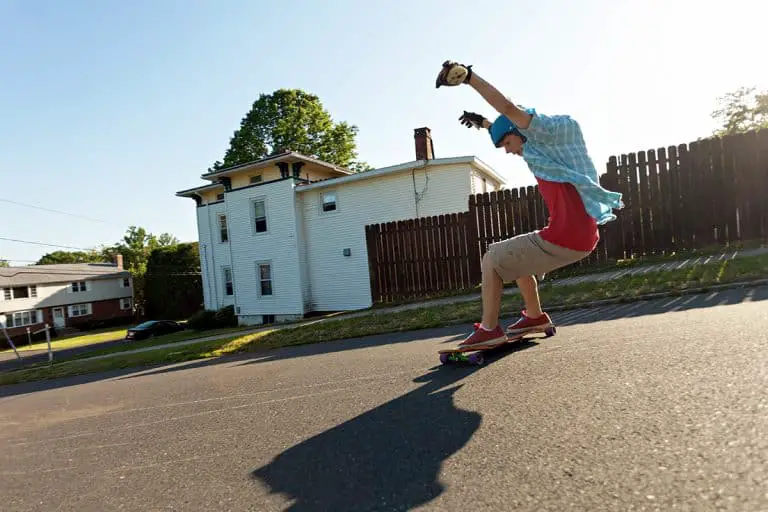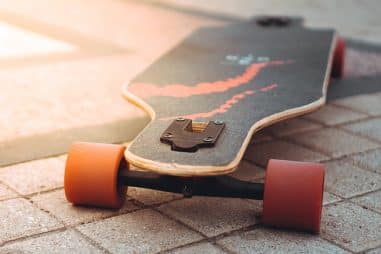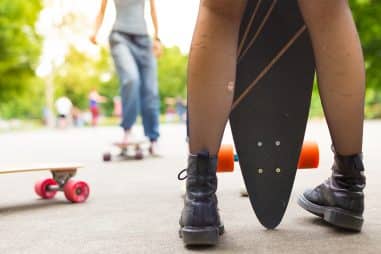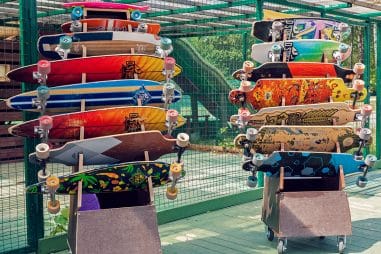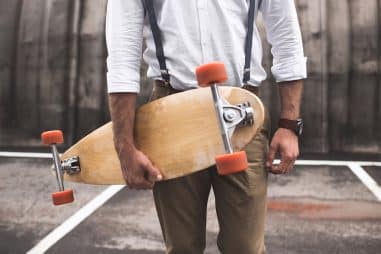Longboarding is one activity that appeals greatly to thrill-seekers because of how fast they can go. But no matter how fun longboarding can be, accidents can still occur so you should always remember to put your safety first.
How Fast Do Longboards Go?
On average, a longboard reaches 6 miles per hour when used for cruising. The average speed often varies in the longboarding discipline.
The maximum speed of your longboards highly depends on you—your riding style, your pushing and pumping strength, the terrain in which you are longboarding in, your weight, your deck, your board type, how comfortable you are in riding fast, and your ability to stop the board.
How Fast Can a Longboard Go on a Flat Ground?
The cruising speed usually clocks between 5 to 14 miles per hour, 6 mph on average.
You may think that it’s automatically faster or easier for you to gain speed on flat ground. However, you can only achieve great speeds if you have effective longboarding pushing and pumping strength . If you master both then get ready to go fast on your longboard.
How Fast Can a Longboard Go Downhill?
The speed of serious downhill riders who often engage in downhill racing typically ranges from 50 to 65 miles per hour.
In some cases, extreme downhill riders even reach insane speed clocking at 80 to even 90 miles per hour. They may even go higher and faster depending on the steepness of the hill and the topography of the terrain.
Is Longboarding Faster Than Walking?
Longboarding is evidently faster than walking. Even those who walk fast can’t beat the effect that a longboard’s wheelbase and bigger wheels have.
No matter how fast you walk, your longboard can take you to your destination faster and it can even extend the range of destination that you wouldn’t even be able to reach if you are just relying solely on your legs.
How Much Faster Is Longboarding Than Walking?
With an average cruising speed of 6 miles per hour, studies have shown that longboarding happens to be two to four times faster than the speed of walking.
This is why boarders would often take their longboards out on the road for transportation than go through the hassle of walking.
Are Longboards Faster Than Bikes?
Bikes are a lot quicker than longboards. Sure, it can be as fast when going downhill but generally and in almost all types of terrain, bikes are faster.
If you are deciding to go farther or to conquer greater distances, then you are better off with a bike because they have better gears and maneuverability than can support your riding goals.
What Type of Longboard Is the Fastest?
If you are on the lookout for the fastest longboard type, then you better go pick a decent downhill longboard like a drop platform or a drop through deck. These are good options because they both offer stability and turning ability, both of which are very important in downhill speed riding.
Because both boards ride lower and their decks are positioned near the ground compared to other longboard types, your center of gravity is also lower which makes riding it very stable even if you are going at great speeds.
Do Longer Longboards Go Faster?
Compared to other boards with much smaller decks like penny boards, longer longboards are in fact a lot faster. This is because longer longboards have bigger wheels that not only accelerate but also hold speed.
On the other hand, penny boards usually come in 59-millimeter wheels. While these help in making the board nimble and easier to maneuver, it doesn’t hold speed that well.
How Fast Do Electric Longboards Go?
While most electric longboards reach the speed of around 18 to 83 miles per hour, there are top models that can exceed 40 mph.
Electric longboards can have different speeds. This is due to several factors including your weight, the size of the wheel, the power of the motor, the terrain of the place that you are skating in.
What Is the Fastest Electric Longboard?
The Guinness World Record holder for the fastest electric longboard is the NEXTBoards which was customized by Next Generation Vehicles.
In 2016, skater Mischo Erba set the record after riding the board at the Slovenian airport going at a record-setting speed of 95.83 kilometers per hour or 59.55 miles per hour.
How Do I Increase My Longboard Speed?
Here are some of the things that you can do to increase your speed.
- Adjust your axle nuts: The tightness of your axle nuts affects your speed. If they are too tight, they will hinder the wheels from spinning freely, however, if they are too loose the nuts might come off of the axle. Loosen it just enough so the wheels can spin freely, and you can move from side to side without too much effort.
- Pay attention to your bearings: Dirt can accumulate fast on your bearings. This would create friction causing your board to slow down. The good news is that it is pretty easy to clean your bearings. Just pop them off of the wheels, wipe them clean with a cloth, soak them in cleaning liquid, dry them one by one, and, finally, lubricate them with silicon-based lube.
- Upgrade your bearings: If you have gone through all the trouble of cleaning and lubricating your bearings but your longboard stays slow, you may want to consider buying new ones. More often than not, your average longboard is equipped with average bearings that eventually need upgrading anyway. Choose quality bearings that have three important characteristics including curvature, plastic cage, and removable rubber seals.
- Get new wheels: If you have done all of the above and you still have a slow longboard, you might want to upgrade your wheels. Choose bigger ones because they are faster even on rough terrain. Also, consider getting harder wheels and larger cores because they have less compression making them considerably fast especially on smooth surfaces.
How Do You Measure Speed on a Longboard?
Over the years, people have come up with different inventions to measure their speed on a longboard. But why go through the trouble when you can just measure your speed using a simple app on your phone, right?
The Longboard SpeedMeter is a mobile app supported by both iOS and Android which doesn’t just record your run; it also measures and takes not of your top and average speed, distance, and elevation drop.
What Is the Fastest Someone Has Gone on a Longboard?
The world record for the fastest speed on a longboard is a staggering 146.72 kilometers per hour or 91.17 miles per hour. The record was set by United Kingdom longboarder Pete Connolly during the L’Ultime Descente – Top Speed Challenge which took place in Canada.
Connolly is now a Guinness World Record holder and is recognized to be the fastest man on a longboard.
Is Longboarding Safe or Dangerous?
Longboarding is both as safe and as dangerous as you make it to be.
While it is relatively safe because of the protective gear that you can equip yourself with, it is also a known fact that longboarding does involve risk, some disciplines more so than the others.
Ultimately, your safety is in your hands. Wear your safety gears, be mindful of your surroundings, and, if possible, bring a friend with you to keep tabs on your safety and progress.
How Dangerous Is Longboarding?
New studies have shown that longboarding injuries can be more severe than injuries from skateboarding. These injuries mostly occur in the upper body such as cuts and heavy bleeding of the head, brain injuries like concussions, and fracture of the skull.
It was also determined that girls suffer more injuries while longboarding than skateboarding.
Is Longboarding in the Rain Bad?
If you are thinking of speeding away on your longboard under the pouring rain, then don’t. Remember that it is not advisable to ride your board through puddles so imagine just how much more damaging riding through the rain is for your board.
If you are still not convinced, here are some more reasons not to ride in the rain:
- Damaged board: Water is one of your board’s greatest enemies. If your board gets soaked in the rain and you don’t take care of it after, it will get waterlogged. The water may cause the wood to weaken making it prone to warping, or worse, causing the layers of your board to split.
- Damage bearings: Water can soak your bearings too! If you don’t clean your bearings immediately, they will start to rust. Although you may not feel the difference early on, your board will start to get slower and slower after some time.
- Accidents: Rain = slippery roads. Slippery roads = less traction. That means during sharp turns, your board can easily slide off of your feet causing you to fall. You are also most likely to have a hard time controlling your board on wet surfaces. Take extra caution if you happen to be riding on slippery surfaces.
Has Anyone Died Longboarding?
People have died due to longboarding. In 2012, there were five recorded longboarding-related deaths across the United States and Canada. These deaths sounded the alarm which caused some cities to consider prohibiting longboarding in their areas.
In 2015, another longboarding-related death was recorded in Pinebrook Boulevard in Summit Park, Utah, when a man was found unresponsive following a longboarding accident. He suffered severe injuries that ultimately led to his death.
How Do You Control Speed on a Longboard?
Controlling your speed, especially if you are a beginner, can be hard, but it is one of the first things that you must learn. If you are scared of losing control, then push your board little by little. There is no sense in pumping so much if you can’t even control your board.
The first and most important step in learning how to control your speed is knowing and mastering how to stop your board, especially in high speed situations.
How Do You Stop Yourself on a Longboard?
There are several ways on how you can stop your longboard. Remember that you don’t have an emergency button to use when longboarding so learning these techniques before riding is of the utmost importance.
- Running it out: This one is easier to understand than done due to the obvious risks. In doing this technique, you must jump off the board and run so your board will slow down. Don’t do this alone or in areas populated with vehicles.
- Carving: It is one of the easiest ways to stop your board. This involves making a zigzag pattern, back and forth when you are going downhill effectively slowing down your board and allowing you to control your board.
- Sliding: Although sliding is a relatively more advanced way of slowing down and stopping your board, beginners can still it. In this technique, you need to twist your board in a controlled manner and allow your wheels to skid along the pavement while also placing your hands on the group to stop you from continuously sliding. Always remember to wear a longboarding slide glove if you are thinking of doing this technique.
How Do You Stop on a High Speed Longboard?
One technique that downhill longboarders often do to control their speed when going downhill is called air braking. It is basically a reverse downhill tuck but this one relies heavily on increasing wind resistance instead of decreasing it.
If you want to stop your high speed descent, slowly “un-tuck” or straighten yourself from your downhill tuck. Slowly raise your chest and upper body and spread out your arms. This move would give the wind more surface area which would then increase the resistance of the wind causing your board to slow down and eventually stop.
How Do You Foot Brake on a Longboard?
Foot braking is one of the most fundamental stopping techniques in longboarding and the easiest to learn as well.
To do this, you must first balance yourself on your leading foot. Try to lower your body down to a slight squat and slowly lower your back foot until it touches the ground. Drag your back foot across the ground until your board starts to slow down and eventually stop.

